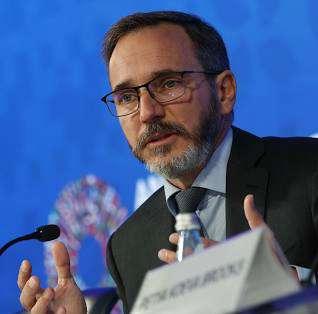
3 minute read
Banks to cut down lending -IMF predicts

There could be contraction in lending by nancial insti tutions, as a result of nan cial turbulence the world experienced last month, the International Monetary Fund (IMF) has cautioned.
Advertisement
Speaking at a press brie ng on Tuesday at the 2023 Spring Meetings in Washing ton DC, USA under the auspices of the IMF and the World Bank Group, Pierre-Olivier Gourinchas, the Chief Economist and director research said broader markets have remained calm and volatility has been contained including for emerging and developing economies, increasing funding costs and the need to act more prudently however “may push banks to cut down lending further, in a world economic outlook we explore such a scenario and nd that it will lead to an additional zero point three percent (0.3%) reduction in output this year.
Yet the nancial sector may well be tested even more, nervous investors often look for the next weakest link as they did with Credit Suisse [a global systemic but ailing European bank]”
The Chief Economist further indicated that nancial institutions with excess leverage, credit risks or interest rate exposure, too much dependence on short term funding
By Eugene Davis
“It will precipitate large capital out ows, a sudden increase in risk premium, dollar appreciation in a rush towards safety and major decline in global activity that may lower con dence, in such a severe downsize scenario, global growth this year could fall to about one percent (1%). We are entering a tricky phase during which economy growth remains low by historical standards, nancial risks have increased, yet in ation has not decidedly turned the corner. Policy makers will need a steady hand and clear communication.” tation the central bank will prematurely surrender the in ation ght and would have opposite e ect lower in yields, supporting activities beyond what is warranted ultimately tral banks. Fiscal policy can also play any active role by cooling o economic activity and tighter scal policy would support monetary objectives.
For Mr. Gourinchas, to be able to contain nancial instability, monetary policy should remain focused on bringing in ation down but stand ready to adjust promptly as nancial developments might demand, adding that the silverlining is that the contraction in bank lending could partially mitigate the need for further monetary policy tightening.
“Appropriate designed scal consolidations can help rebuild much needed scal bu ers and help strengthen nancial stability,” he noted.
According to Mr. Gourinchas, the short policy tightening in the last 12 month is starting to have on the nancial sector and “we have repeatedly worn that this will not be an easy ride, following a prolonged period of muted in ation and low interest rate, the nancial sector had become complacent towards maturity and liquidity mismatches.”
Further, he noted that last year’s rapid policy tightening triggered sizeable losses on term xed income assets and increased banks funding costs; “the brief in stability last fall in the UK and the recent banking turbulence in the USA illustrate instead that signi cance vulnerabilities do exist both among banks and non-bank nancial institutions and both cases we have recommended
Story continues on page 3

Story continued from page 2 quick and strong action and so far, have prevented further instability.
Sub-Sahara Africa facing slow growth
As regards the Sub-Saharan African region, the Fund maintained that it is su ering from a slowing growth to about 3.6percent in 2023 from 3.9percent last year, there is also situation with in ation which is elevated to 16percent but is expected to reduce to about 12.3percent. Another challenge facing the region as a result of elevated food price is that there are large number of people facing food insecurity close to 130m
The Fund in its World Econom- ic Outlook baseline forecast is for growth to fall from 3.4 percent in 2022 to 2.8 percent in 2023, before settling at 3.0 percent in 2024. Advanced economies are expected to see an especially pronounced growth slowdown, from 2.7 percent in 2022 to 1.3 percent in 2023. In a plausible alternative scenario with further nancial sector stress, global growth declines to about 2.5 percent in 2023 with advanced economy growth falling below 1 percent.
Global headline in ation in the baseline is set to fall from 8.7 percent in 2022 to 7.0 percent in 2023 on the back of lower commodity prices but underlying (core) in ation is likely to decline more slowly. In ation’s return to target is unlikely before 2025 in most cases.










